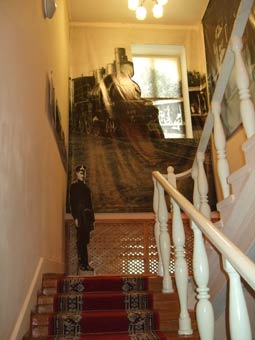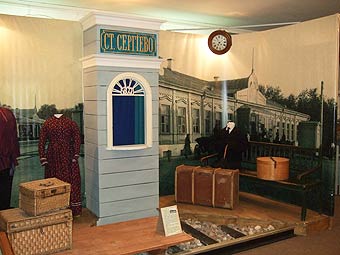Exhibition “At the Trinity in Sergiev Posad” (p. 1)
 In 1862, when the Trinity railway was opened, there were only four stations: Mytishchinskaya, Pushkinskaya, Talitskaya (now Sofrino), Khotkovskaya – and two terminals. In 50 years they constructed more platforms: Perlovskaya, Taininskaya, Tarasovskaya, Klyazma, Mamontovskaya, etc. At the beginning of the 20th century, the 3-d class ticket price was 80 kopecs, that was two times cheaper than the cheapest ticket in the passenger-and-mail carriage. The passengers were pilgrims, businessmen from Sergiev Posad, professors of the Moscow Theological Academy, students, industrialists.
In 1862, when the Trinity railway was opened, there were only four stations: Mytishchinskaya, Pushkinskaya, Talitskaya (now Sofrino), Khotkovskaya – and two terminals. In 50 years they constructed more platforms: Perlovskaya, Taininskaya, Tarasovskaya, Klyazma, Mamontovskaya, etc. At the beginning of the 20th century, the 3-d class ticket price was 80 kopecs, that was two times cheaper than the cheapest ticket in the passenger-and-mail carriage. The passengers were pilgrims, businessmen from Sergiev Posad, professors of the Moscow Theological Academy, students, industrialists.
The exhibition begins in the foyer, where you can read information about the railway, see a view of Moscow of the mid-19th c. and a real pillar with posters of the early 20th century.
Climbing the stairs, you can set out on an imaginary travel by train to Sergiev Posad, passing by the stations and platforms (presented in the photographs of that time).
 The first hall
The first hall
So you reach Sergievo station. Here you can see the reconstruction of the railway station in Sergiev Posad (the building is still used as the station), maquette of a ticket window and models of passengers with contemporary baggage and travelware.
In the show-case one can see travel accessories of the early 20th century – One-way 2-d class ticket, leather PURSE, paper money, copper COINS, COUNTING FRAME, a SMALL GLASS in a case, PENCIL in a metal pencil case, FOLDER, double-sided PENCIL, leather BELT with a buckle “North R.”, PINCE-NEZ, travel ICON, DISCRIPTION of the Holy Trinity-St. Sergius Lavra, POST-CARDS with the Lavra views.
 The town, spreading around the Trinity-St. Sergius Lavra at the beginning of the 20th century, combined the crowded center and quiet green back streets of cozy houses with carved window-frames. There lived craftsmen. Most of them were connected with pilgrim service. Every day a lot of people arrived in Sergiev Posad. The guests spent here one or three days and stayed at the place they could afford. There were hotels, pilgrim hostels and private houses providing furnished rooms or beds. (The maquette of the facade of the town house is demonstrated). For the Sergiev Posad inhabitants lodging was an important part of income alongside with trade and toy and souvenir production.
The town, spreading around the Trinity-St. Sergius Lavra at the beginning of the 20th century, combined the crowded center and quiet green back streets of cozy houses with carved window-frames. There lived craftsmen. Most of them were connected with pilgrim service. Every day a lot of people arrived in Sergiev Posad. The guests spent here one or three days and stayed at the place they could afford. There were hotels, pilgrim hostels and private houses providing furnished rooms or beds. (The maquette of the facade of the town house is demonstrated). For the Sergiev Posad inhabitants lodging was an important part of income alongside with trade and toy and souvenir production.
|


